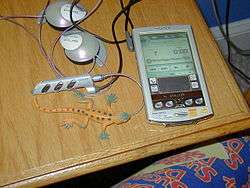CLIÉ
 | |
|
The CLIÉ N760C with its included headphones and the Audio Player program. | |
| Manufacturer | Sony |
|---|---|
| Type | Personal digital assistant |
| Retail availability | 2000–2005 |

The Sony CLIÉ was a series of personal digital assistants running the Palm Operating System developed and marketed by Sony from 2000 to 2005. The devices introduced many new features to the PDA market, such as a jog-wheel interface, high-resolution displays, and Sony technologies like Memory Stick slots and ATRAC3 audio playback. Most models were designed and manufactured in Japan. The name is an acronym for creativity, lifestyle, innovation, emotion though formerly communication, link, information and entertainment. It was initially an attempt at a new coinage term, though it means "tool" in the Jèrriais language.
The CLIÉ handhelds were distinguished from other Palm OS models by their emphasis on multimedia capabilities, including photo, video, and audio playback, long before any other Palm OS PDAs had such capabilities. Later models have been credited with spurring competition in the previously stagnant Palm market, closing many of the gaps that existed between Palm OS PDAs and those powered by Microsoft's Windows Mobile operating system, particularly on the multimedia front, but also with Sony's proprietary application launcher interface.
Closure of handheld line
In the summer of 2004, Sony announced that new CLIÉs would, from then on, be manufactured and available only in Japan, and in the spring of 2005, Sony announced the total termination of its CLIÉ line of products. The last models to be released worldwide were the PEG-TJ27, PEG-TJ37, and PEG-TH55. The last model released in Japan was the PEG-VZ90. Soon after the closure of the CLIÉ line, Sony stopped providing original installation drivers, including Sony's version of Palm Desktop for the CLIÉ, which are necessary for Hotsyncing with the PC and otherwise taking advantage of the handhelds' many features for which a PC may be required. Several CLIÉ fans took it upon themselves to offer these drivers freely for download at www.sonyclie.org.
Models
CLIÉ handhelds were released in series, usually with a few models released in each series. In later years, multiple series would be in production at the same time.
Motorola Dragonball CPU/Palm OS 3.5 & 4.x
- S series (2000–2002)
- T series (2001–2003)
- N series (2001–2002)
- NR series (2002)
- SL/SJ series (2002–2003)
ARM compatible CPU/Palm OS 5.0 & 5.2
- NX series (2002–2004)
- NZ series (2003–2004)
- TG series (2003–2004)
- UX series (2003–2004)
- TJ series (2003–2004)
- TH series (2004)
- VZ series (2004–2005) (Japan only)
Macintosh support
Officially, the CLIÉ line did not support the Mac OS, and Sony never provided any software with the handhelds for Mac OS. However, as a Palm OS device, every CLIÉ handheld was inherently capable of HotSync operations with a Mac OS computer. This allowed for the synchronization of the basic PIM functions, as well as for the installation of new software, though this inherent capability was unusable because the Mac HotSync software would not recognize the handheld. PalmSource, however, silently added the capability to recognize older CLIÉ devices when providing new versions of its Palm Desktop software for Mac. This was necessary for those who could synchronize only via USB.
The CLIÉ user community soon discovered that these "updates" were simply a matter of adding a few lines to the USB-detection property-list file.[1] Since then, detailed instructions have been posted online for those who want to synchronize their CLIÉ handhelds. No modifications are required for Bluetooth synchronization, but Wi-Fi synchronization is impossible because the Mac OS HotSync software does not support network synchronization. Some workarounds for the multimedia features also exist. For those who desire stronger Mac OS/CLIÉ integration, the product Missing Sync[2] made by the company Mark/Space[3] is also available. This does make unencrypted Wi-Fi synchronization possible but a bug in the CLIÉ network stack reverses IP addresses which means that the Macintosh involved needs a palindromic IP address such as 10.0.0.10.
See also
- Android (operating system)
- Graffiti (Palm OS)
- Palm OS
- PalmSource, Inc.
- Personal digital assistant
- Smartphone
- Sony Ericsson XPERIA X10
- Walkman
References
External links
- Sony repair/parts replacement website - Buy replacement parts for current un-supported Sony CLIÉS.″″
- One Source - Formerly CLIÉ Source, One Source is a CLIÉ enthusiast site which changed its name when Sony ended the CLIÉ line. It is still the more popular site that still talks about the Sony CLIÉ line of products through its forums.
- SonyClie.org - Downloadable PC-Clie drivers which are no longer provided by Sony.
- Openomics - Step-by-step instructions to add Apple iSync support for a Sony CLIÉ TH55
